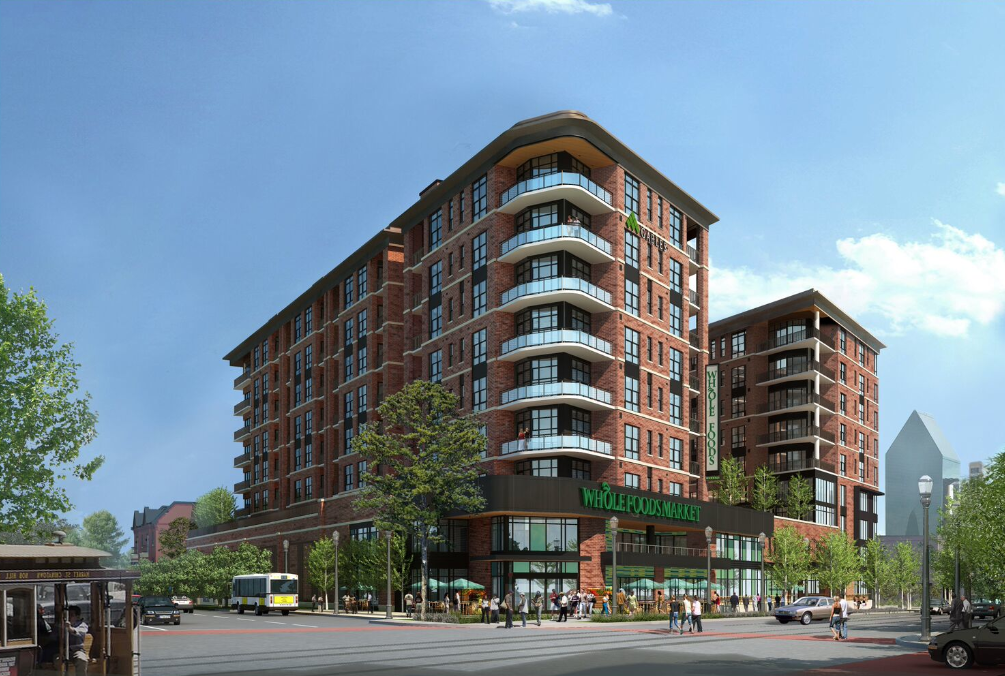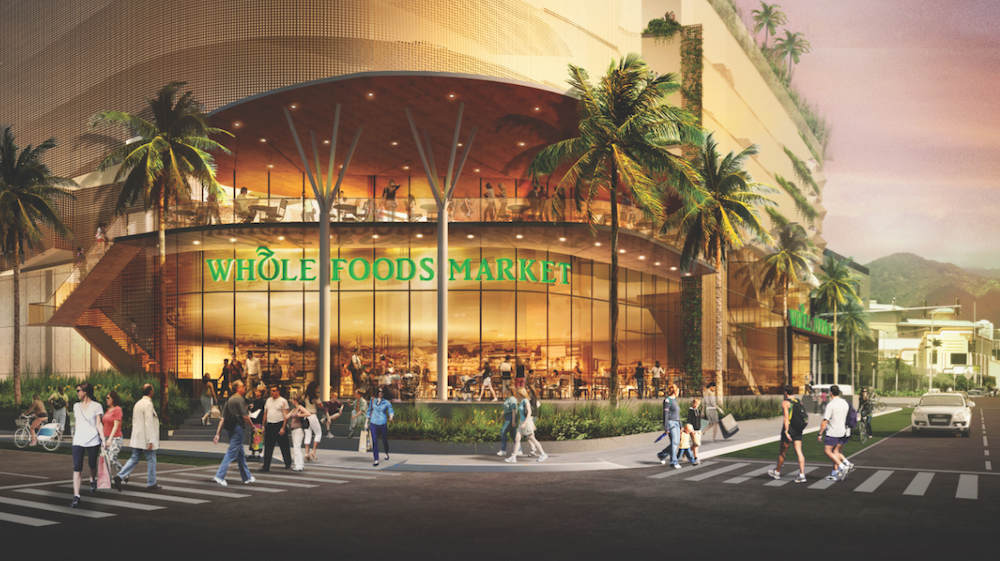In July, the Howard Hughes Corporation began selling condos in Ae’o, one of five residential towers that the developer is building within its 60-acre master planned Ward Village on the Hawaiian island of Oahu.
When it’s completed sometime in 2018, the Bohlin Cywinski Jackson-designed Ae’o will have 466 residences that range from 409 to 1,331 sf and start in the low $400s. At the base of that tower will be a 50,000-sf Whole Foods Market.
Supermarkets have always been sought-after—and, some would argue, essential—tenants for mixed-use projects, especially for those in urban areas where grocery stores have become harder to come by.
In Boston, Millennium Tower at Downtown Crossing, a 60-story luxury high rise with 442 units, is scheduled to open in the summer of 2016 next to a new 37,000-sf Roche Bros. gourmet supermarket. In Newark, N.J., a former 440,000-sf Hahne Department Store is currently under reconstruction by L+M Development and Hanini Group as a building with 160 mixed-income apartments and a 29,000-sf Whole Foods on the ground floor. And Extell Development has promised the community to include an affordable supermarket as part of the retail component of its Two Bridges tower project in Manhattan, which is being built on land where a Pathmark supermarket was closed to make way for the residential buildings. Lend Lease is the construction manager on this project.
 Whole Foods within Eighth & Grand in Los Angeles, image courtesy Carmel Partners
Whole Foods within Eighth & Grand in Los Angeles, image courtesy Carmel Partners
Carmel Partners’ Eighth & Grand, a 700-unit mixed-use community designed by Commune, is currently preleasing and should open later this year. The ground floor of this three-acre site features the first Whole Foods Market to open in downtown Los Angeles. And in Dallas’s Uptown neighborhood, Gables Residential has had a waiting list since September 2014 for the 222 apartments and 17 townhomes in its eight-story Gables McKinney Avenue building, which sits atop a Whole Foods that opened on August 12. The urbanized supermarket includes a coffee and smoothie bar, a café, and a taproom with 24 taps for beer, wine, and cold-brew coffee.
Whole Foods Market, with 408 stores in the U.S., has operated in Hawaii for seven years and currently has four stores in the state. The Oahu location will be the retail supermarket’s first on that island and its flagship in Honolulu.
“Our focus is to bring in the best retailers for the daily needs” of residents and the local community, says Nick Vanderboom, Senior Vice President of Development at Ward Village. One of the other towers that Hughes is planning for Ward Village—988 Halekauwila, with 424 for-sale units, which opens in 2019—will include a 23,000-sf full-service Long’s Drugs at street level.
Ward Village on Oahu is designed to be Hawaii’s first LEED Platinum ND-certified development. Vanderboom acknowledges that the decision to include a supermarket in a residential tower “always complicates the design.” Sanitation and logistical issues must be addressed. As for parking, Hughes decided to put the lot for the supermarket and other retail within the tower above the stores, and have a separate area for resident parking.
This is a combination that Hughes likes elsewhere, too. Vanderboom says the developer has two stateside mixed-used projects that include Whole Foods: in Columbia, Md., a $25 million adaptive reuse of the 89,000-sf Rouse Company’s headquarters; and new construction in The Woodlands in Houston, where the supermarket will be next to the apartment tower and other retail.
 Whole Foods at the base of the Gables McKinney Avenue building in Dallas, image courtesy Gables Residential
Whole Foods at the base of the Gables McKinney Avenue building in Dallas, image courtesy Gables Residential
Related Stories
| Sep 23, 2011
Under 40 Leadership Summit
Building Design+Construction’s Under 40 Leadership Summit takes place October 26-28, 2011 Hotel at the Monteleone in New Orleans. Discounted hotel rate deadline: October 2, 2011.
| May 17, 2011
Redesigning, redefining the grocery shopping experience
The traditional 40,000- to 60,000-sf grocery store is disappearing and much of the change is happening in the city. Urban infill sites and mixed-use projects offer grocers a rare opportunity to repackage themselves into smaller, more efficient, and more convenient retail outlets. And the AEC community will have a hand in developing how these facilities will look and operate.
| Apr 12, 2011
Retail complex enjoys prime Abu Dhabi location
The Galleria at Sowwah Square in Abu Dhabi will be built in a prime location within Sowwah Island that also includes a five-star Four Seasons Hotel, the healthcare facility Cleveland Clinic Abu Dhabi, and nearly two million sf of Class A office space.
| Mar 30, 2011
Big-box giants downsize, open smaller, urban stores
As U.S. chain retailers absorb the lessons of the Great Recession, many big-box chains have started to shrink average store footprints to reflect the growing importance of multi-channel shopping, adapt to urban settings, and recognize the need to optimize portfolios. Wal-Mart, Target, Best Buy, and the Gap, among others, all have small concepts in the works or are adapting existing ones. These smaller store formats should allow the retailers to maximize profitability and open more stores in closer proximity to each other.
| Mar 22, 2011
Mayor Bloomberg unveils plans for New York City’s largest new affordable housing complex since the ’70s
Plans for Hunter’s Point South, the largest new affordable housing complex to be built in New York City since the 1970s, include new residences for 5,000 families, with more than 900 in this first phase. A development team consisting of Phipps Houses, Related Companies, and Monadnock Construction has been selected to build the residential portion of the first phase of the Queens waterfront complex, which includes two mixed-use buildings comprising more than 900 housing units and roughly 20,000 square feet of new retail space.
| Feb 23, 2011
Unprecedented green building dispute could cost developer $122.3 Million
A massive 4.5 million-sf expansion of the Carousel Center shopping complex in Syracuse, N.Y., a project called Destiny USA, allegedly failed to incorporate green building components that developers had promised the federal government—including LEED certification. As a result, the project could lose its tax-exempt status, which reportedly saved developer The Pyramid Cos. $120 million, and the firm could be penalized $2.3 million by the IRS.














